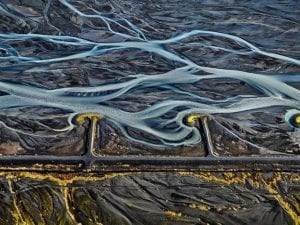Simone Nieweg (b. 1962), a pupil of renowned German photographer Bernd Becher, began her journey at the Kunstakademie Düsseldorf in the 1980s. The artist focused on the intersection of human and nature-utilised places, exploring the aesthetics of unplanned space. Utilising a large-format camera, the artist captured the essence of various regions — Rhineland, different parts of Germany, and locales in France — through vibrant colour photography. Her work observed the overlooked areas of urban and industrial zones. It’s an oeuvre that doesn’t claim the same magnitude as Andreas Gursky — who also studied at the Kunstakademie — but, one, that all the same, generates a sense of reverence. Rather than concentrating on monument or scale, Nieweg hones in on the intimate. Green gourds spring off winding vines whilst peach trees bloom in a hazy spring. All this informs Nieweg’s Plants, Sheds, Arable Land: Working in Nature, now on display at SK Stiftung Kultur, Cologne, in a retrospective that brings together 40 years’ worth of work.

Nieweg captures the elements of arable land: alternative allotments, pieces of meadow and plowed fields in winter. She sheds light on the untameable, giving rise to a kind of nature that exceeds its cultivation. In one image, a singular wheelbarrows is heaped with weeds, stationed next to a pair of blue compost bins. Taken in Pontalier, on the border of Switzerland, the picture evokes Van Gogh’s Wheatfield with Cypresses (1889), painted when the artist was at a psychiatric hospital in Saint-Paul de Mausole in the South of France. Unlike Van Gogh’s painting, however, Nieweg’s photograph depicts the presence of human intervention. The result is a feeling of both tranquility and unease as orderly vegetable patches give way to an unending expanse of green. We feel that things balance on the precipice between order and chaos.


Elsewhere, we see a light yellow pumpkin in full bloom, supported by a sturdy pole and base underneath. Beside, appears a greenhouse fitted with a structural steel grid, covered with sheets of plastic insulation. The wooden door, left ajar, permits a viewer to see the inner lining of the curved structure. We’re shown what it means to hold something in, to shield it from the elements, reinforcing its integrity and purpose. Nieweg possesses an inward-looking lens that invites viewers to a covert and special space. Her attention to detail imbues nonhuman subjects with personality, wonder and importance. It’s an effortless guise that is reminiscent of Dewi Lewis’ recent publication Pictures From the Garden, a series of photographic essays on memory and grief, inspired by British photographer’s Paddy Summerfield’s own experience with loss.

In Garden with carpet tiles (1986), Nieweg shows a sepia-coloured shed covered with green fabric squares. The image was taken in Meldorf Holstein, near to the artist’s homeground in North Rhine-Westphalia. It shows a makeshift building that stands out from its surroundings all the while being inextricably entangled with it. “These often improvised, yet carefully crafted, one-of-a kind buildings were in fact the starting point for my preoccupation with the theme of landscape. Such structures could be found almost exclusively in undeveloped areas not affected by municipal land-use,” explains Nieweg in Schirmer/Mosel Verlag’s accompanying publication. Human impact is not detrimental but exerts a patient craftmanship. As Heinz Liesbrock writes in Nature, man-made, “When nature is worked with simple, hand-held tools, the traces of man’s labor take on a special immediacy.” These are spaces that have been attentively and lovingly planned. We’re reminded of the possibilities of living in and with our environment, cultivating our gardens with care.
Plants, Sheds, Arable Land: Working in Nature | Until 21 January
Words: Chloe Elliott
Image Credits:
Landscape with vegetable beds and wheelbarrow, Pontarlier, 2004 © Simone Nieweg, VG Bild-Kunst, Bonn, 2023
Garden with limed trees, Dijon, 2009 © Simone Nieweg / VG Bild-Kunst, Bonn
Pumpkin with support, Neuss-Holzheim, Rhineland, 2008 © Simone Nieweg / VG Bild-Kunst, Bonn, 2023
Greenhouse with structural steel grid, Dillingen 2004 © Simone Nieweg / VG Bild-Kunst, Bonn, 2023
Garden with carpet tiles, Meldorf-Holstein, 1986 © Simone Nieweg, VG Bild-Kunst, Bonn, 2023





